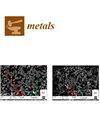Hydrogeochemical Facies and Health Hazards of Fluoride and Nitrate in Groundwater of a Lithium Ore Deposit Basin
IF 2.5
3区 材料科学
Q3 MATERIALS SCIENCE, MULTIDISCIPLINARY
引用次数: 0
Abstract
Fluoride and nitrate contamination in groundwater is a global concern due to their toxicity and associated negative health effects. This study incorporated a comprehensive methodology, including hydrogeochemical analysis, drinking and irrigation water quality assessment, source apportionment, and health risk estimation of groundwater fluoride and nitrate in a lithium ore deposit basin in western Serbia. Groundwater major ion hydrogeochemistry was governed by water–rock interactions, with Ca-Mg-HCO3 identified as the predominant groundwater type. The entropy-weighted water quality index (EWQI), sodium adsorption ratio (SAR), and sodium percentage (%Na) revealed that 95% of the samples were of excellent to good quality for both drinking and irrigation. Moreover, the results showed that fluorides were of geogenic origin, whereas nitrates originated from agricultural activities. Although the fluoride and nitrate levels in groundwater were relatively low, averaging 1.0 mg/L and 11.1 mg/L, respectively, the results of the health risk assessment revealed that the ingestion of such groundwater can still lead to non-cancerous diseases. The threshold of one for the hazard index was exceeded in 15% and 35% of the samples for adults and children, respectively. Children were more vulnerable to non-carcinogenic risk, with fluorides being the primary contributing factor. The study outcomes can serve as a reference for other lithium-bearing ore areas and guide the management of regional groundwater resources.锂矿床盆地地下水中氟化物和硝酸盐的水文地质化学面貌及其对健康的危害
地下水中的氟化物和硝酸盐因其毒性和对健康的负面影响而受到全球关注。这项研究采用了一种综合方法,包括水文地质化学分析、饮用水和灌溉水水质评估、水源分配以及塞尔维亚西部锂矿床盆地地下水氟化物和硝酸盐的健康风险评估。地下水主要离子水文地球化学受水与岩石相互作用的影响,Ca-Mg-HCO3 被确定为主要的地下水类型。熵加权水质指数 (EWQI)、钠吸附率 (SAR) 和钠百分比 (%Na) 显示,95% 的样本水质为优至良,适合饮用和灌溉。此外,研究结果表明,氟化物来源于地质活动,而硝酸盐则来源于农业活动。虽然地下水中的氟化物和硝酸盐含量相对较低,平均分别为 1.0 毫克/升和 11.1 毫克/升,但健康风险评估结果显示,摄入此类地下水仍可能导致非癌症疾病。分别有 15% 和 35% 的成人和儿童样本的危害指数超过了 1 的临界值。儿童更容易受到非致癌风险的影响,而氟化物是主要的致病因素。研究结果可为其他含锂矿区提供参考,并指导区域地下水资源的管理。
本文章由计算机程序翻译,如有差异,请以英文原文为准。
求助全文
约1分钟内获得全文
求助全文
来源期刊

Metals
MATERIALS SCIENCE, MULTIDISCIPLINARY-METALLURGY & METALLURGICAL ENGINEERING
CiteScore
4.90
自引率
13.80%
发文量
1832
审稿时长
1.5 months
期刊介绍:
Metals (ISSN 2075-4701) is an open access journal of related scientific research and technology development. It publishes reviews, regular research papers (articles) and short communications. Our aim is to encourage scientists to publish their experimental and theoretical results in as much detail as possible. Therefore, there is no restriction on the length of the papers. The full experimental details must be provided so that the results can be reproduced. Metals provides a forum for publishing papers which advance the in-depth understanding of the relationship between the structure, the properties or the functions of all kinds of metals.
 求助内容:
求助内容: 应助结果提醒方式:
应助结果提醒方式:


